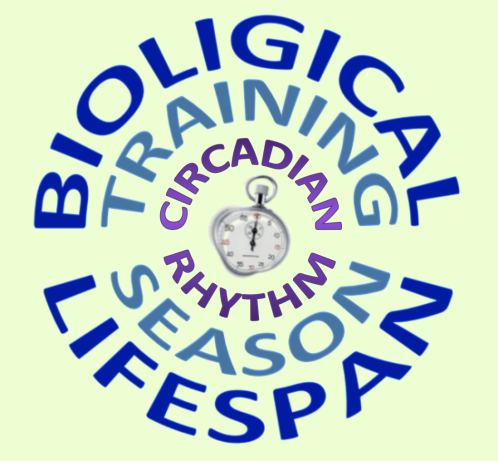The Endocrine system displays temporal variation in release of hormones. Integrating external lifestyle factors with this internal, intrinsic temporal dimension is crucial for supporting metabolic and Endocrine health.

Amplitude and frequency of hormonal secretion display a variety of temporal patterns:
- Diurnal variation, synchronised with external light/dark. Orchestrated by a specific area of the hypothalamus, the neuroendocrine gatekeeper.
- Circadian rhythm, roughly 24-25 hours which can vary with season according to duration of release of melatonin from the pineal gland.
- Infradian rhythms longer than a day, for example lunar month seen in patterns of hypothalamic-pituitary-ovarian axis hormone release during the menstrual cycle.
- Further changes in these temporal release and feedback patterns occur over a longer timescale during the lifespan.
Hormones influence gene expression and hence protein synthesis over varying timescales outlined above. The control system for hormone release is based on interactive feedback loops. The hypothalamus is the neuroendocrine gatekeeper, which integrates external inputs and internal feedback. The net result is to maintain intrinsic biological clocks, whilst orchestrating adaptations to internal perturbations stimulated by external factors such as sleep pattern, nutrition and exercise.
Circadian alignment refers to consistent temporal patterns of sleep, nutrition and physical activity. Circadian misalignment affects sleep-architecture and subsequently disturbs the interaction of metabolic and Endocrine health. This includes gut-peptides, glucose-insulin interaction, substrate oxidation, leptin & ghrelin concentrations and hypothalamic-pituitary-adrenal/gonadal-axes. The main stimuli for growth hormone release are sleep and exercise. Growth hormone is essential for supporting favourable body composition. These integrated patterns of environmental factors may have a more pronounced effect on those with a genetic predisposition or during crucial stages of lifespan. For example curtailed sleep during puberty can impact epigenetic factors such as telomere length and thus may predispose to metabolic disruption in later life. Regarding activity levels, there are strong relationships between time spent looking at screens and markers, such as insulin resistance, for risk of developing type 2 diabetes mellitus in children aged 9 to 10 years.
In addition to adverse metabolic effects set in motion by circadian misalignment, bone turnover has also shown to be impacted. Circadian disruption in young men resulted in uncoupling of bone turnover, with decreased formation and unchanged bone resorption as shown by monitoring bone markers. In other words a net negative effect on bone health, which was most pronounced in younger adult males compared with their older counterparts. These examples underline the importance of taking into account changes in endogenous temporal patterns during the lifespan and hence differing responses to external lifestyle changes.
For male and female athletes, integrated periodised training, nutrition and recovery has to be carefully planned over training seasons to support optimal adaptations in Endocrine and metabolic networks to improve performance. Training plans that do not balance these all these elements can result in underperformance, potentially relative energy deficiency in sport and consequences for health in both short and long term.
Part 2 will consider the longer term consequences and interactions of these temporal patterns of lifestyle factors, including seasonal training patterns in male and female athletes, on the intrinsic biochronometry controlling the Endocrine and metabolic networks during lifespan.
References
Sports Endocrinology – what does it have to do with performance? Dr N.Keay, British Journal of Sports Medicine 2017
One road to Rome: Metabolic Syndrome, Athletes, Exercise Dr N. Keay
Metabolic and Endocrine System Networks Dr N. Keay
Endocrine system: balance and interplay in response to exercise training Dr N.Keay
Sleep for health and sports performance Dr N.Keay, British Journal of Sports Medicine 2017
Factors Impacting Bone Development Dr N. Keay
Sleep, circadian rhythm and body weight: parallel developments Proc Nutr Soc
Sleep Duration and Telomere Length in Children Journal of Paediatrics 2017
Screen time is associated with adiposity and insulin resistance in children Archives of Disease in Childhood
Circadian disruption may lead to bone loss in healthy men Endocrine today 2017
Successful Ageing Dr N. Keay, British Association of Sport and Exercise Medicine 2017
Clusters of Athletes – A follow on from RED-S blog series to put forward impact of RED-S on athlete underperformance Dr N. Keay, British Association of Sport and Exercise Medicine 2017
Optimal Health: For All Athletes! Part 4 – Mechanisms Dr N. Keay, British Association of Sport and Exercise Medicine 2017